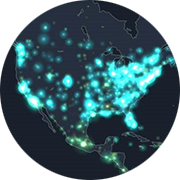Most recent ransomware outbreaks
What is Petya ransomware?
The Petya malware attacks a computer's MBR (master boot record), a key part of the startup system. If the attack is successful, the computer user then receives a message that the files have been encrypted, with a demand that a ransom be paid to release them.
On June 27, 2017, a ransomware attack known as Petya (detected by ESET as Win32/Diskcoder.C Trojan) began spreading rapidly around the globe.
What is WannaCry ransomware?
When WannaCry touches a user’s computer, it encrypts all its files, effectively locking them up and making them unavailable to the victim. A ransom is demanded in the form of Bitcoin in exchange for restoring access to the files. The price for unlocking the data and hardware increases with time. If the payment isn’t made by the deadline, the computer is rendered permanently inaccessible.
On May 12, 2017, a ransomware attack known as WannaCry (detected by ESET as Win32/Filecoder.WannaCryptor.D) spread rapidly across the globe.
Why you need ransomware protection
In 2016, the U.S. Department of Justice revealed that the Internet Crime Complaint Center (IC3) had received nearly 7,700 public complaints regarding ransomware since 2005, totaling $57.6 million in damages. Those damages include ransoms paid—generally $200 to $10,000, according to the FBI—as well as costs incurred in dealing with the attack and estimated value of data lost. In 2015 alone, victims paid over $24 million across nearly 2,500 cases reported to the IC3.
How ESET protects against ransomware

Ransomware Shield
Uses multilayered malware prevention and detection to keep criminals from holding your data hostage.

Network Attack Protection
Prevents spread of ransomware by protecting against vulnerabilities for which a patch has not yet been released or deployed.

Cloud Malware Protection System
Analyzes submitted malware and provides results to endpoints without requiring an update.

EternalBlue Vulnerability Checker
Checks the operating system (Windows) to see if it's patched against the vulnerabilities exposed by the latest Petya and WannaCry outbreaks.


![Are you ransomware-aware? [PDF] Are you ransomware-aware? [PDF]](/fileadmin/_processed_/a/9/csm_ransomware-pdf-thumb_2ca3780500.png)